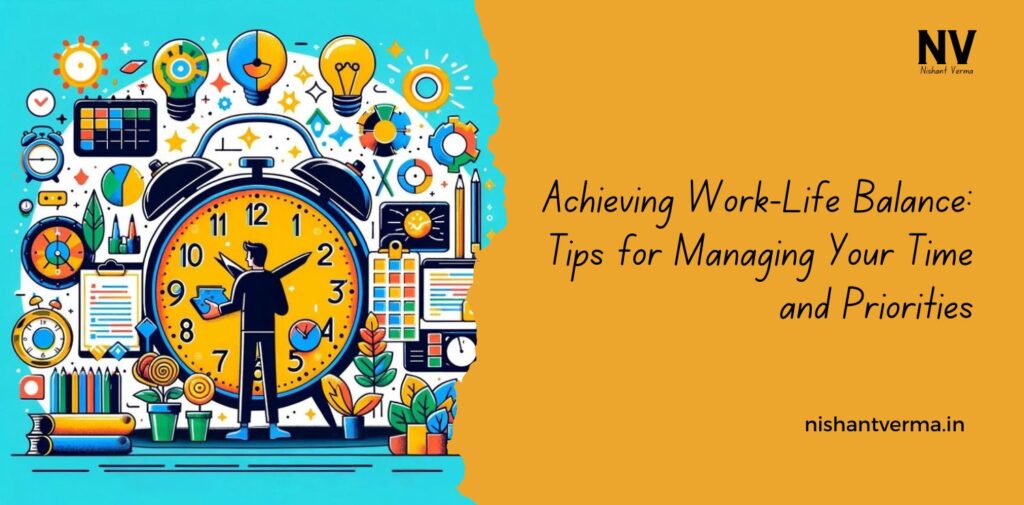In today’s fast-paced world, many of us are balancing multiple roles – as employees, students, parents, children, friends, and more. It often feels like there’s just not enough time in the day to do everything we want to. Juggling work, family, and personal well-being can be overwhelming, but finding the right balance is not only possible – it’s essential. By managing our time and setting priorities wisely, we can lead a more peaceful, productive, and fulfilling life.
What is Work-Life Balance?
Work-life balance refers to the idea of giving equal importance to your professional responsibilities and personal life, ensuring that neither dominates the other. This doesn’t mean that work should always take second place, or that personal life should always come first. It’s about finding a harmonious balance that allows you to give attention to both without suffering. When you manage your work and personal life effectively, you experience less stress and more satisfaction.
Think of it like balancing two baskets – one filled with work tasks and the other with family, health, hobbies, and relaxation. If you keep adding too many tasks to the work basket, the personal life basket will become empty. Similarly, if you focus only on your personal life and neglect work, your career might suffer. The key is to find the right balance between both baskets.

Simple Tips to Achieve Work-Life Balance
1. Set Clear Boundaries: Setting clear boundaries is one of the easiest ways to achieve work-life balance. When you’re working, focus on work. When you’re at home or with family, leave work behind. This may involve turning off work notifications or setting a specific time to stop working every day.
Example: Rani, a software developer in Bengaluru, used to check her work emails late into the night. After realising that it was affecting her sleep and family time, she set a rule to stop working at 7 p.m. Now, she enjoys undistracted evenings with her family, cooking dinner or watching a movie together.
2. Learn to Say No: Saying yes to everything can quickly lead to burnout. It’s essential to respect your time and limits. Saying no doesn’t mean being selfish—it means you’re prioritising your well-being.
Example: Vijay, a teacher in Mumbai, loved being involved in every school activity. But he realised that by attending all the events, he was missing quality time with his family. Now, he carefully assesses his commitments and politely declines activities that don’t align with his priorities.
3. Prioritize Your Tasks: With so much on our plates, it can be hard to know where to start. The key is to prioritise tasks. What’s most important right now? What can be done later? Make a list of your tasks and sort them by urgency and importance.
Example: Priya, a working mother in Delhi, found herself overwhelmed with both her office and home responsibilities. By writing a to-do list every morning, she realised that spending quality time with her kids was just as important as any work task. She now focuses on the most crucial tasks first, while leaving the less urgent ones for later.

4. Make Time for Yourself: Self-care is often the first thing we neglect when juggling responsibilities. But taking time for yourself is crucial for mental and physical well-being. Whether it’s a quick workout, reading, or just relaxing, ensure you allocate time for activities that recharge you.
Example: Arvind, a busy software engineer and father in Hyderabad, used to work long hours and help with his children’s studies, leaving no time for himself. He now wakes up 30 minutes earlier for some quiet meditation and a cup of tea, helping him feel more calm and focused throughout the day.
5. Be Present in the Moment: In a world full of distractions, it’s easy to divide your attention. Whether you’re working or spending time with loved ones, try to be fully present. Turn off distractions, and engage with what you’re doing at the moment.
Example: Aarti, a college student in Pune, used to try studying while watching TV or replying to messages. She realised this wasn’t effective. Now, she keeps her phone on silent during study sessions and focuses solely on her work. When spending time with friends, she disconnects from her phone to enjoy the moment.
6. Delegate and Ask for Help: You don’t have to do everything on your own. If you’re feeling overwhelmed, ask for help or delegate tasks. At work, delegate a project to a colleague. At home, share household responsibilities with your family members.
Example: Sanjay, a busy accountant in Chennai, used to take care of all the housework himself, even though his wife worked too. Realising he was burning out, he started involving his children in small tasks like setting the dinner table. This simple step lightened his workload and created a more balanced family routine.
7. Create a Routine: Having a daily routine can bring structure to your day and help you stay on track with your priorities. You don’t need to plan every minute, but setting aside time for important tasks can help you achieve balance.
Example: Neha, a freelance graphic designer in Kolkata, used to work late into the night and struggled to separate work from her time. After creating a routine where she worked from 9 a.m. to 5 p.m. and set aside evenings for relaxation, she became more productive during work hours and had more free time afterwards.

8. Embrace Flexibility: Life is unpredictable, and things don’t always go according to plan. Embrace flexibility, understanding that sometimes work or personal responsibilities may take more time than expected. Flexibility helps reduce stress and lets you adjust when necessary.
Example: Rohit, a lawyer in New Delhi, used to get upset when plans changed unexpectedly. Now, he builds some buffer time into his schedule to account for delays or sudden family obligations. By being flexible, he’s learned to stay calm and reduce stress, even when things don’t go as planned.
Conclusion
Achieving work-life balance is not about perfection; it’s about finding what works for you. With small changes like setting boundaries, prioritising tasks, and making time for yourself, you can create a life where both your personal and professional worlds coexist peacefully.
Remember, it’s okay to say no, ask for help, and adjust your plans when needed. Everyone’s work-life balance will look different—what works for one person may not work for another. The key is to take small steps toward creating a life that feels right for you.
How do you manage your work and personal life? Do you have any tips or strategies that have helped you achieve balance? Share your thoughts, and let’s learn from each other!




